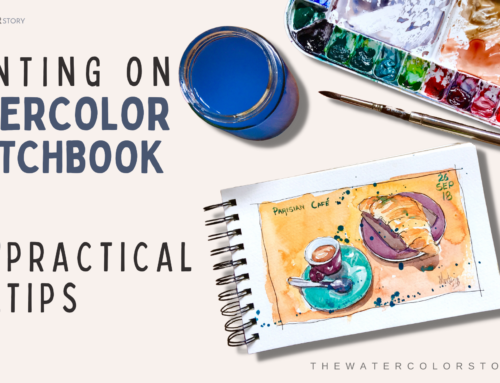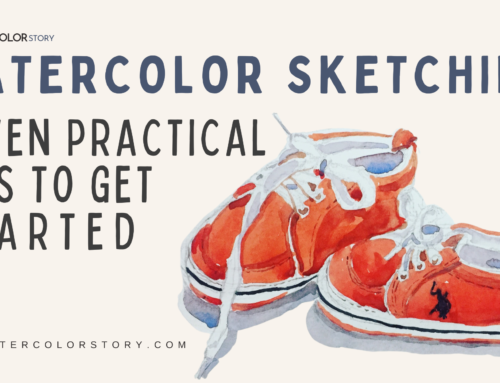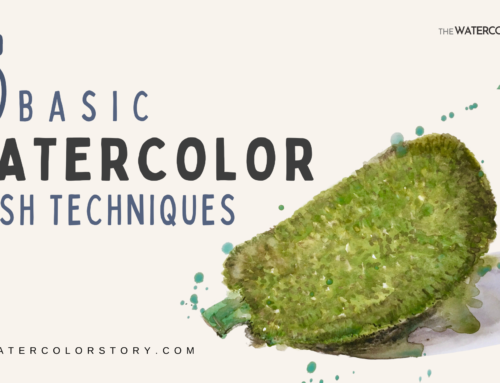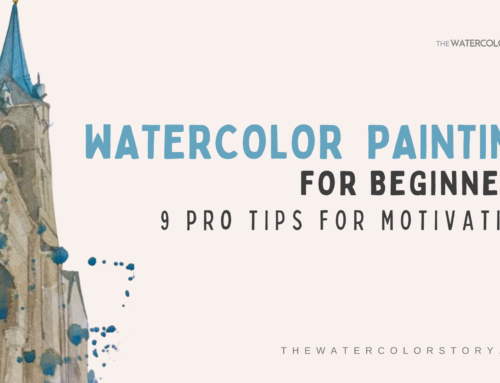When you are into watercolors, outdoor painting, also known as Plein Air, is one of the most vital things,that will boost up your growth in the medium. This is also true to any medium in painting.
Drawing from life is something that is always encouraged due to the many benefits that it has to offer.
You get to see things from a right perspective, not limited to the two dimensional feel that you will get in a photo.

Renowned Watercolorist Megha Kapoor, while painting outdoors in Shillong, India
Do check out Megha Kapoor’s Instagram profile to see her works
You will know the mood better, your tonal values will be of a better understanding to you & not to mention the perspective, which is the most important element in a painting.
While I stress on the importance of outdoor painting, I think it would be of some help to you, if I can give you a few simple but important tips on how to make your painting experience pleasant.
The below mentioned tips are just enough to get you started on a positive note:
1. PACK LIGHT:
When planning outdoor painting, mobility is the key.
You don’t want to take unwanted/heavy items on your backpack.
Take only the most necessary things with you as you are now out of your physical comfort zone, i.e the studio.
When I go for outdoor painting, I only take one Sketchbook, two brushes & the pre-filled palette with some other ultra light items in my backpack.
That way I don’t have to worry about unpacking too many items once I choose a spot, as well as repacking once done.
2. USE A LIMITED PALETTE:
Here limited palette refers to your choice of colors.
A limited palette is basically a selection of a few warm & cool paints along with some opaque & transparent ones.
This way you gain two things: First, you don’t have the confusion in mind, with a wide choice of colors.
You already know you have your limitations & have to work within that.
This saves your energy for other aspects of the painting.
Second and perhaps the more important gain is that you learn to mix colors.
This will be of great help in your journey & you will definitely get your own style in watercolors sooner than expected.
ALSO READ: How to get your own style in Watercolors
3. DON’T EXPECT CONSISTENT LIGHTING:
If you are just starting out in the practice of outdoor painting, you should keep this in mind that light is not consistent throughout your activity of painting.
Morning light is soft, afternoon lights warmer and so on. Keeping this in mind will help you maintain a color balance in the painting & save you from the unpleasant finishes.
You can also use DIY diffusers if you are painting on an easel.
4. PAINT LOOSE:
Try painting loose representation of whatever you observe.

Image Copyright: Namchai Saensupha
A detailed painting is not desirable when doing plein air work at the beginning of your learning process.
Later when you gain more control of your art & the medium, you can attempt for a bit more details provided, the timing as well as lighting conditions allow you to do so.
5. WEAR A HAT OR A CAP:
Wear a hat or a cap that protects your face from the glare of the sun.
With this glare, you will not be able to mix colors in the right way, leading to unwanted warmth or coolness to the color of the work.
I recently came across an online forum, where someone was ranting about the fact that majority of the artists wear hats while painting outdoor to look cool or create an identity or to get attention.
But little do this person knows about the fact mentioned above, as well as another important one, that no artist wants attention while painting outdoors.
He or She simply wants to paint alone peacefully.
6. DO LOTS OF THUMBNAIL SKETCHES:
Try making lots of thumbnail sketches of the subjects that you see.
Design or Composition is one of the most vital elements in a painting.

Thumbnail Sketches
With thumbnail sketches, you get a better understanding of the subject, what to include & most importantly what to exclude in the composition.
It does not have to be detailed painted tiny works.
You can simply pick up a pencil, a rough paper & make a few rectangles & start interpreting the subject in various ways, until you get an eye-pleasing composition.
Another important thing that you will learn from this is tonal value. This is as important as the design or composition element.
7. MAKE THE PRELIMINARY PREPARATIONS AT HOME:
Since painting outdoors will be very different from studio paintings & have limitations of light, time, weather etc, it is very much advisable to do the necessary preparations at home itself. Few small but important things to do would be:
a. Fill your palette with paints at home & let it dry a bit, so that it doesn’t spill while carrying.
b. Cut, Stretch & mount your paper on the board
c. Arrange your art supplies in the most minimal way. Take only whats needed.
d. Pack something to eat & drink if you are going to paint for a longer time
8. CARRY ENOUGH WATER:
While this may seem to be a silly tip, but its worth reminding that carrying limited water for painting will limit you in the number of paintings that you can make.
You cannot use the same water for a fresh painting & hence you will require another mug of water. And most of the time you will not have access to water
Using the same water will result in a muddy looking work, which you don’t want.
9. IGNORE THE ONLOOKERS
I am a very shy person myself & what kept me off for a long time from outdoor painting was the attention from the onlookers.
I don’t like being bothered while i am painting, but this is exactly what i get everytime i go to paint.
Sometimes, i get silent viewers, while most of the times, i would get people who would never stop talking.
Very soon I realised that this is the way it is & it should be me who figures out a way to deal with this.
The simplest remedy I found was to simply ignore everything around you & focus on the subject & your painting.
This sounds difficult, but once you know that this is what you should do, you will figure it out on your own how to do it.

BONUS CONTENT:
Now that I have chalked out a few tips for you, I hope you will start going out for painting soon and come back with some really nice paintings/sketches.
But before that I have 4 bonus tips from one of my artist friend Saurabh Pramanik who paints outdoor more often than I do. Mountains are his speciality & he has experience of painting in watercolors in freezing temperatures. Isn’t that supercool?
Here are his tips:
- Due to so many sensation and changes in the atmosphere, i take a picture just to frame my subject. That way if things change then i go back to the snap to remind me how things were when I began.
- One learning is not to stand in the sun and paint, that sometimes creates a problem with the paper and also physical discomfort.
- It is also very important to adapt to the place, like for example once when i was painting in sub zero temperatures, and the paint and water were freezing, i had to paint really fast.
- Of course for plein air it is also very advisable to have a good easel and materials. Sometimes searching for stuff in the middle of a painting can be a very frustrating.
That’s it guys. These are the 9 practical tips I shared along with 4 bonus tips from Saurabh, so that you can be inspired, knowledge equipped & just focus on the learning experience of the painting.
Do check out Saurabh’s paintings on his Instagram Profile by clicking HERE
Also, please share your feedback, your outdoor painting experiences in watercolors as well as your tips from personal experiences. We would love to learn from you too.





Leave A Comment